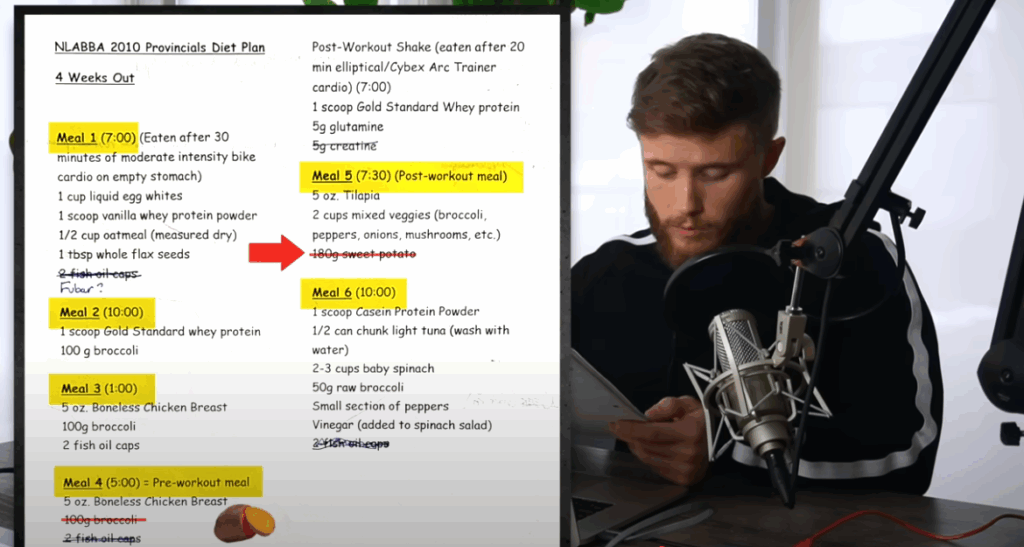Revisiting a Decade-Old Bodybuilding Diet: What I Learned and What I’d Change
Over the years, our understanding of nutrition and fitness has evolved dramatically. Reflecting on our past choices can offer valuable insight into what works, what doesn’t, and what we’ve learned along the way. In this article, I’m revisiting a strict bodybuilding diet I followed 10 years ago while preparing for a competition. While the plan helped me achieve a lean and muscular physique, it wasn’t without its flaws. Here’s my in-depth breakdown, including what I’d do differently today.

The Old-School Meal Plan Mentality
At the time, I believed in following a rigid meal schedule—eating the same foods at the exact same times daily. There was no calorie tracking, no macro calculation—just blind faith in specific “clean” foods eaten at precise intervals. The belief was simple: eat these foods, get shredded.
Looking back, that approach lacked the flexibility and scientific backing that we now recognize as essential for both physical progress and mental sustainability.
Macros Breakdown: Excessive Protein, Minimal Fats
After retroactively calculating the diet’s macros, it was clear that protein intake was excessive—around 265 grams per day, far more than necessary for muscle preservation. Simultaneously, fats made up a mere 13% of total calories—far below the recommended 15–20% minimum needed for hormonal balance and overall health. This imbalance could potentially hinder testosterone levels and affect long-term muscle retention.
For contest prep today, I’d aim for moderate protein (around 1.0–1.2g per pound of lean body mass), healthy fats in the 20% calorie range, and carbs as high as possible while maintaining a slow, steady fat loss.
Fasted Cardio: Outdated Fat Loss Strategy
The day started with fasted cardio, based on the idea that training on an empty stomach would enhance fat burning. Current research, however, suggests there’s no significant difference between fasted and fed cardio in terms of fat loss. What matters more is overall energy balance and consistency. If you prefer training fasted and it fits your lifestyle, great—but it’s not a metabolic secret weapon.

The Breakfast Breakdown
My first meal featured egg whites, oatmeal, protein powder, and whole flax seeds. While nutrient-rich, the protein content was overkill. A more balanced version today would include whole eggs for healthy fats and micronutrients, perhaps paired with fruit instead of a shake to add fiber and natural sugars.
Also, the flax seeds were consumed whole, which is a mistake—your body can’t digest the seed shell effectively unless it’s ground. Today, I’d use ground flax or rotate in fats like avocado or nut butter for variety and improved nutrient absorption.
Meal Timing Obsession
One of the more amusing quirks was my insistence on eating meal two—whey protein and raw broccoli—at exactly 10 a.m., often during university lectures. While there’s nothing wrong with this simple snack nutritionally, the obsession with precise timing wasn’t necessary. Nutrient timing is a secondary concern compared to total daily intake.
I’d also argue for swapping in more enjoyable and varied snacks—maybe a protein bar with a piece of fruit or Greek yogurt with berries and almonds. This enhances adherence and prevents diet fatigue.
Chicken and Broccoli on Repeat
Two of the meals consisted solely of chicken breast and broccoli, with fish oil pills for healthy fats. While technically fine, it lacked variety, flavor, and sufficient carbohydrates—especially concerning for a pre-workout meal. Relying on fibrous vegetables for training fuel isn’t optimal.
A better approach would involve adding sweet potatoes, rice, or oats before training, paired with a lean protein source. Simple carbs before a workout support energy and performance, while fiber-heavy foods like broccoli can cause digestive discomfort during intense training.
Post-Workout Nutrition: Misplaced Priorities
I used to slam a protein shake right after my session, thinking it was essential for muscle recovery. However, if you’ve had a protein-rich meal within a few hours before training, the anabolic window is more flexible than previously believed. The amino acids from that pre-workout meal are still active.
In hindsight, I’d skip the post-workout shake and head straight to a solid food meal around 1–2 hours post-training—something like salmon, rice, and a variety of colorful vegetables for micronutrients and satiety.
The “Magical” Tilapia Myth
Dinner included tilapia with mixed vegetables. While tilapia is a lean protein, it was often praised in bodybuilding circles for supposedly drying you out or thinning the skin. These myths have no scientific basis. A better substitute today might be salmon, which offers omega-3s and tastes better for many people. Replacing supplements with whole food sources, when possible, is always a smart move.
Bedtime Nutrition: Casein and Tuna?
The final meal of the day featured casein protein powder and canned tuna. While casein is a solid slow-digesting option for overnight muscle repair, canned tuna is less appetizing for most people—and not necessary. Cottage cheese is a better alternative here, offering casein protein plus calcium and other nutrients. I’d also consider adding some slow-digesting carbs like oats or fruit to improve sleep quality.
The myth that carbs before bed lead to fat gain has long been debunked. Your overall calorie balance dictates fat loss or gain—not the timing of your carbohydrate intake.

Final Thoughts: Rating the Old Diet
Looking back, I’d give this diet a 4 out of 10. It got a few things right:
- High vegetable intake
- Adequate (if excessive) protein
- Reasonable calorie levels—not dangerously low
But there were many areas for improvement:
- Too rigid: The lack of flexibility made it mentally exhausting.
- Low fat: Far below optimal for hormone support.
- Repetitive food choices: This could lead to nutrient gaps.
- Poor pre-workout nutrition: No fast-digesting carbs when they mattered most.
- No fruit: Avoiding natural sugars out of fear was misguided.
- Too many shakes: Missing out on micronutrients from whole foods.
What I’d Do Differently Today
If I were to redo that contest prep now, my plan would look like this:
- Start with macro targets based on my body weight and goals.
- Allow for flexible food choices within those macros.
- Ensure each meal is balanced with protein, carbs, and healthy fats.
- Prioritize pre- and post-workout meals for performance and recovery.
- Use whole foods whenever possible, reserving supplements for convenience.
- Add variety for better micronutrient coverage and diet satisfaction.
Conclusion
Bodybuilding diets have come a long way. What once felt like a gold-standard approach now seems overly restrictive and outdated. The key takeaway? Don’t blindly follow a plan just because it once worked. Adapt, evolve, and build a diet that fits your lifestyle, supports your training, and keeps you healthy—both mentally and physically.
If you’re interested in an in-depth guide on body recomposition, complete with training, nutrition, and supplementation strategies, keep an eye out for our upcoming comprehensive resources.



